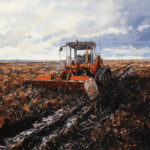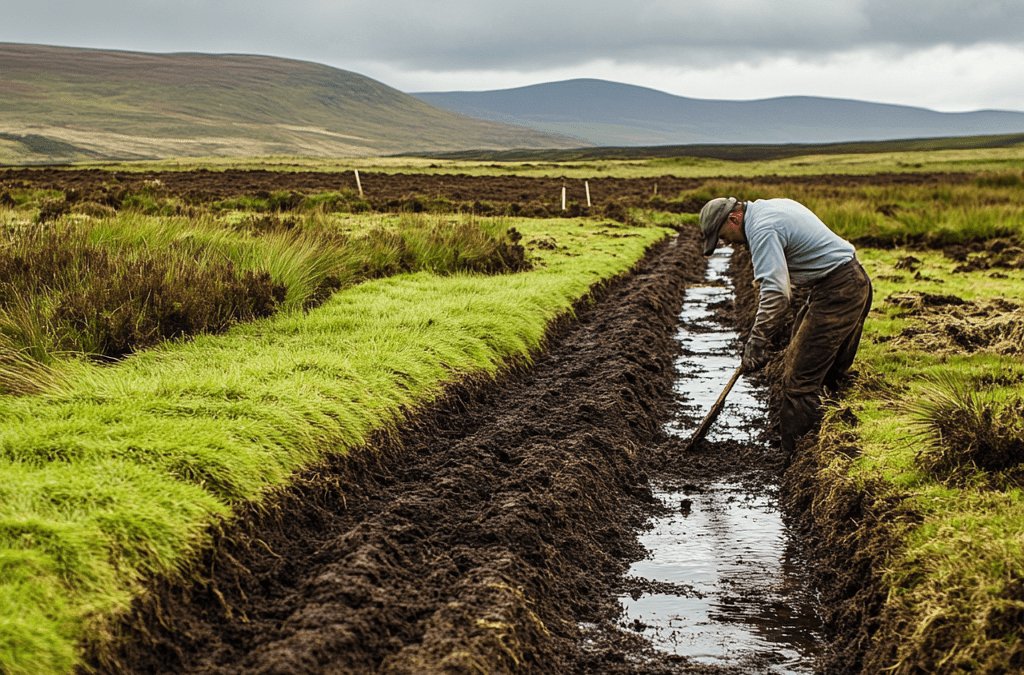‘Unauthorised activity’ of peat extraction sites at bogs seen, with €39m worth of turf exported last year
The Environmental Protection Agency (EPA) has opened scores of investigations into suspected illegal peat extraction at bogs all over the country.
Files released by the agency show clear evidence of large-scale commercial peat extraction in multiple counties – all believed to be unauthorised.
Photos show expensive machinery, complex drainage systems, extensive rows and stacks of cut peat and, in some cases, large warehouses on sites.
That is despite a ban on the commercial sale of peat for solid fuel heating and the restriction of peat-cutting for other purposes, such as horticulture, to plots that have environmental assessments, planning permission, EPA licences or both.
Experts with knowledge of the issue say very few, if any, plots have such permits or would be eligible for them because they would fail at the environmental assessment stage.
Yet Central Statistics Office figures show 351,000 tonnes of peat worth €39m was exported last year alone.
Files released by the EPA to the Right To Know organisation under Access to Information on the Environment regulations relate only to site inspections carried out from spring of last year.
Their inspection reports show large areas of peatland being stripped in nine counties. Typical findings feature in the following extracts:
“Machinery and equipment for peat harvesting were noted at this location and these included an excavator, attachment for large sod peat excavation, tractor and trailer.”
“Large stockpiles of milled peat were noted at the site. Significant quantities of bagged material were stored at the site.”
“A peat processing and bagging plant is also located at the site.”
“Drainage works were noted to have been carried out over an extensive part of the peatland.”
“The scale of the activity and the area involved is on a commercial scale.”
“Four excavators were noted to be present along with a number of dumpers for collecting the peat. A conveyor for loading lorries was also present.”
During most inspections, no personnel were on site but occasionally people were encountered at work.
One report stated: “The harrowing of milled peat was taking place during the visit. Once we entered the peatland, the milled peat harrowing was noted to cease.”
Another recorded: “The EPA inspectors informed the driver of the excavator of the purpose of the visit but he declined to provide any information.”
On other sites, people told the inspectors they were harvesting sites less than 30 hectares in size.
Sites over 30 hectares automatically require planning permission. Sites over 50 hectares require planning permission and an EPA licence.
It’s a full-scale industry
Sites up to 30 hectares almost always need planning permission too, except in very limited circumstances where exemptions apply.
Ashley Glover of Right to Know said government policies with the stated aim of phasing out peat extraction had allowed a narrative to develop that only small, traditional peat cutting for domestic use remained.
“In reality, if you look at those operations and the infrastructure and the buildings recorded in those files, it’s a full-scale industry,” he said.
Peat extraction was targeted for phase-out on environmental and public health grounds. Turf-burning is a major contributor to air pollution and bog-stripping has been disastrous for nature.
It has removed habitats, polluted rivers and destroyed the country’s most effective natural “carbon sink” – a landscape that absorbs and holds greenhouse gas emissions.
Successive governments were slow to act on the issues, however, because of the importance of the industry to individual households and the wider rural economy.
It took 10 years of legal challenges by Friends of the Irish Environment (FIE) in the Irish and European courts from 2009 to 2019 for permitting regulations to finally be applied.
If applied, they would have halted extraction on all but the traditional smallholder sites where “turbary rights” exist to take turf for household fuel. Tony Lowes of FIE said the scale of extraction that has continued regardless of the regulations was “gobsmacking”.
There is no doubt this destruction of the peatlands has got to stop
“We spent so much time and energy on this. We went back year after year and eventually An Bord Pleanála and the Government ran out of excuses and the courts sided with us.
“There is no doubt this destruction of the peatlands has got to stop.”
Nature Minister Malcolm Noonan agrees. He said progress was being made in restoring landmark bogs previously worked by Bord na Móna and in convincing smallholders to accept compensation to stop cutting in Special Areas of Conservation (SAC). However, on the question of ongoing larger operations, he said the focus should be on ceasing extraction altogether rather than trying to regularise them through the permitting process.
“What you’re talking about is the big sausage machines and industrial extraction – that has to stop absolutely.”
Mr Noonan said enforcement was key to bringing an end to the activities and that planning authorities should be proactive in inspecting sites.
Mr Glover said that was not realistic as enforcement proceedings could take years to conclude.
“If you don’t put in a proper enforcement regime, you can keep these sites going for another 10 or 20 years easily,” he said. “A different approach is needed. I don’t see why injunctions couldn’t be got to stop operations. Or what you do is, you target the more straightforward violations – on the SACs for example – and you take the keys of the digger.
“Those are €250,000 machines. The contractors would say I’m not going to work on illegal sites because I’ll lose my digger. Problem solved.”
The EPA’s head of enforcement, Dr Tom Ryan, said the agency was stepping up action directly and through local authority planning offices.
We have issued directions to them to prepare countywide enforcement plans
“We’ve been providing them with significant intelligence about what we see as unauthorised activity in their regions of operation,” he said.
Drone footage and aerial maps had been passed on for 38 sites of particular concern – nine in Offaly, eight in Westmeath, six each in Roscommon and Tipperary, four each in Kildare and Longford and one in Sligo.
“We have issued directions to them to prepare countywide enforcement plans against unauthorised peat extraction,” Dr Ryan said.
“They have a legal responsibility to do this. We’re talking about the unregulated destruction of natural habitats for profit.
“These activities are destroying what are very significant carbon sinks in the context of climate change, and causing all sorts of local issues with dust and contamination of water and then the operators walk away and leave a site in a dreadful state.”
Dr Ryan said said the current investigation files, while substantial, did not cover all suspected unlawful extraction.
“The nature of this is that it wouldn’t be surprising if other sites come to our attention,” he said.


